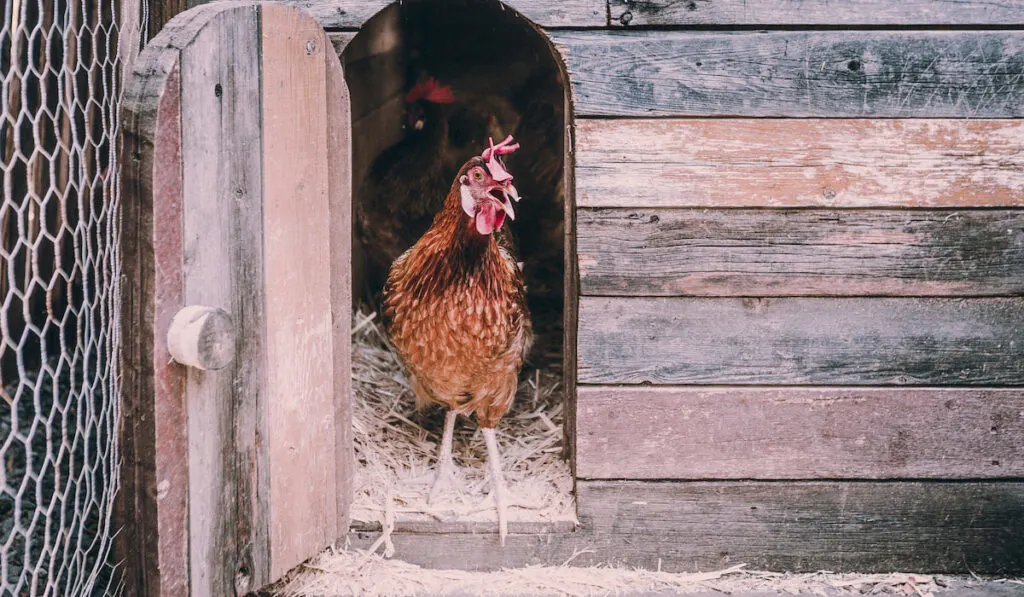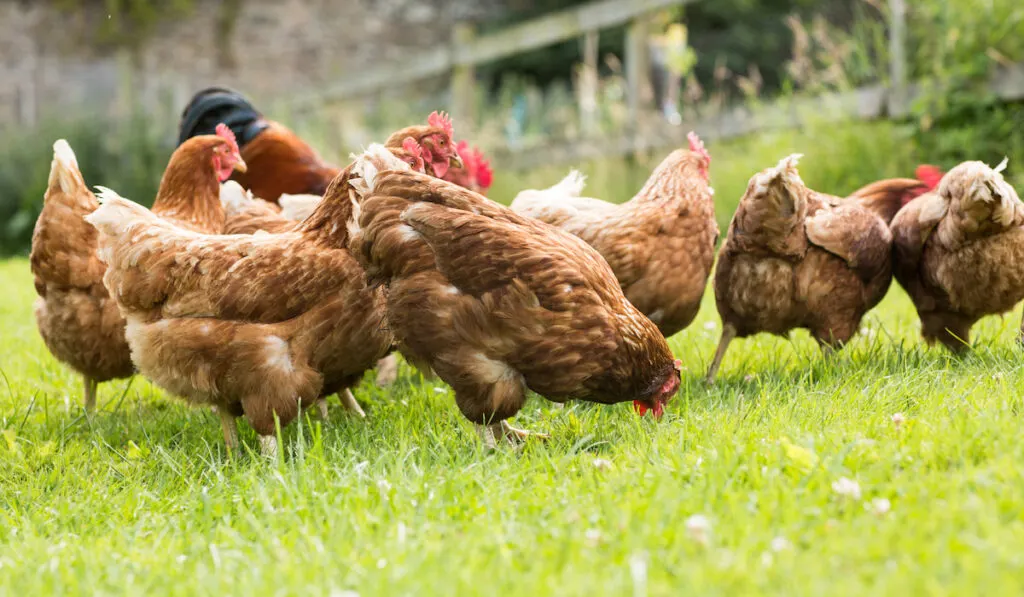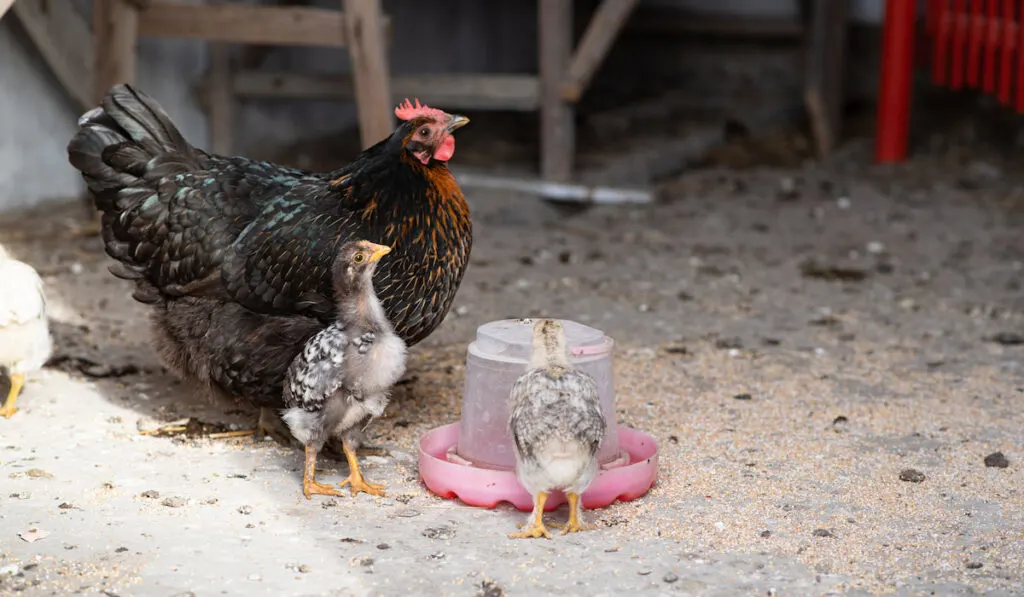Free-range chickens have grown in popularity for the healthy food and animal welfare advantages they bring. Here, we’ll take a look at the pros and cons of raising chickens without a coop, and how you can go about it.
So, how can you raise chickens without a coop? First, you’ll need safe, secure fencing either around a single area of your property or around its perimeter. Additionally, you’ll need to provide laying boxes and access to a covered area such as a shed or porch so the chickens can escape the elements.
Aside from the above, there are a few other things you’ll need to include to ensure the safety, health, and comfort of your chickens. In the next few sections, we’ll go over each topic in depth.

Table of Contents
Pros and Cons of Chicken Coops
Before we dive into how to raise chickens without a coop, it’s worth mentioning that coops do serve a purpose in poultry rearing. Let’s go over some of the pros and cons of coops.
Pros:
- Creates a safe space for chickens to retreat if faced with a predator or harsh weather.
- Keeps the flock confined to a single area rather than near your home or your neighbors’ homes.
- Helps you keep track of your flock better, and makes it easier to monitor their health.
- Great for when you’re raising chickens in urban areas or on limited land.
Cons:
- Coops can become unsanitary very quickly if they aren’t regularly cleaned and maintained.
- Chickens are kept in a confined area and can’t roam or spread out.
- Essential nutrients found in a chicken’s natural diet such as bugs and small rocks aren’t as available as the chickens cannot go and freely search for these.
- More costly in time and resources than free-range alternatives.
The Benefits and Challenges of Raising Chickens Without a Coop
There are pros and cons with raising chickens without a coop. These include:
Pros:
- Chickens are healthier overall – the air is fresher and they aren’t confined in the same space as uneaten feed or feces.
- The flock is able to roam and find minerals and bugs essential to their diet and digestive systems.
- Healthier chickens mean eggs and meat will be more nutritious and with less waste.
- You’ll save money on store-bought chicken feed.
Cons:
- Though you’ll save money on commercial feed, chickens will tear up your gardens if you don’t fence them off.
- Chickens scratch, and will leave holes in your yard.
- Feces will be spread out over your yard.
- You need sufficient land, at least an acre or more is recommended for a flock.
- Chickens can be easy prey for predators.

Chicken Rearing Without a Coop
Now that we’ve covered the basics, we’ll go over how to raise chickens without a coop step-by-step.
1. Determine Where the Chickens will Roam
As we’ve mentioned, chickens make a mess. They don’t care about your pretty flowers, your lawn furniture, or your garden decor, and will quite literally poop all over everything you worked so hard for.
It’s essential to determine exactly where you’ll be allowing your chickens to free roam before you purchase your flock. You can fence off some of your property, or its entirety, depending on your preferences and where you want – and don’t want – your chickens to roam.
2. Have Adequate Fencing
Raising chickens without a coop makes an already vulnerable animal even more susceptible to becoming a coyote’s next meal. That means you’ll want to invest in your fencing. It’s not just to keep your chickens in, it’s to keep predators out.
Because chickens are delicious to not just people, but to just about every carnivore on the planet, it’s vital to install tall, climb-proof fencing around your chicken run. You can use chicken wire, but we recommend double layering it with stronger livestock or dog fencing.
Furthermore, predators such as foxes and coyotes are notoriously intelligent hunters. They will jump over and dig under your fencing, which means you need to bury your wire at least 2-4 feet under the ground. You’ll also want to ensure that your fence is around 6 feet high.
Use large, wooden posts or metal stakes to secure your fencing. Anything flimsy can be easily dislodged by a fox or coyote. You can also try using electrical wire or an electrical fence around the perimeter of the chicken wire as an extra measure of caution.
3. Provide Shelter
Though you won’t be using a coop, which would provide shelter, you’ll still need to provide some sort of housing. Your chickens need protection from cold or hot weather, and your structures act as a second line of defense should a predator get through the fencing.
- Laying boxes are the minimalist farmer’s dream. They don’t provide shelter themselves so need to be placed under an awning or other structure, but they do provide a warm and comfortable spot for hens to lay eggs and rest.
- Three-sided sheds are structures that have three walls and a roof but are open in the front. These sheds allow for the chickens to go in and out of the shelter as they’d like, they protect from wind and other natural elements, and provide at least minimal safety from predators.
- Using your covered porch as a chicken roost isn’t everyone’s ideal, but if you’re on a budget or just really want your chickens to be free, placing some laying boxes on your porch isn’t a bad idea.
Regardless of what method you choose to shelter your chickens, it’s important to keep in mind that while they are resilient animals is some ways, they are not so resilient in others. Chickens can withstand colder temperatures to a point, but they do need protection from high winds and snow.
Though chickens can tolerate warmer temperatures, heatwaves can be detrimental to their health and some shelter provides the shade they’ll need. Lastly, even minimal shelter may prove to be a deterrent to some predators.
Be sure that your shelter area provides at least 4 square feet of room per bird. The more room the better, but 4 square feet is a good general rule of thumb.
4. Access to Food and Water

Like every animal, chickens need access to clean food and water to stay happy and healthy. While free-range chickens will require less commercial feed than cooped chickens, it’s still a good idea to place some chicken feed out in the field or near their shelter in case bugs are scarce.
Replace the feed daily and clean the container after a rain or if ants get into the chicken feed.
Be sure to provide clean, fresh water daily, and keep the container free of debris, dirt, or algae. Water containers should be placed in the shade of a building or tree to keep the temperature down during warmer months.
5. Consider Locking Your Chickens Up at Night
Though the idea when raising free-range chickens is to keep your chickens as unconfined as possible, securing them in a spacious but closed-off, safe area at night is still worth consideration.
Nighttime can be a treacherous time for chickens. This is because as you and your family sleep, predators and scavenging animals are starting to come out and hunt for food.
An easy way to keep your chickens safe at night without making them feel too crowded is by adding a chicken wire and wood gate to a three-walled shelter. This will give them an open, airy shelter to go into at night without the tight, closed-in spaces of your average chicken coop.
6. Check Up On Your Chickens Often
As we’ve mentioned, free-range chickens are an easy target for predators, but they’re also prone to hurting themselves or each other. There are a few things you can do to ensure their safety:
- Remove all sharp debris from their run.
- Cut off and mend any sharp edges on their shelter or on the fencing. Sharp edges can cut chickens if they rub against them while running.
- Test the fencing for any malfunctions, breaks, or holes.
- Look around the fencing for any sign of digging or clawing.
It’s a good idea to check on your chickens at least a few times a day, especially in the mornings and at dusk, as these are the prime times when chickens are active and predators are around.
Potential Predators
Predators are something that you’ll always have to keep an eye out for when raising chickens, no matter the environment. Below, we’ll be exploring some of the most common predators.
Dogs
Though dogs are lovable pets to us, to chickens they can be a danger. Dogs are instinctive hunters, and if they happen to notice a chicken that’s easy to reach, they may attack.
It seems as though if domesticated dogs attack chickens, it’s usually for sport. You won’t often find a chicken come up completely missing if a dog is involved – the body will almost always be nearby.
Signs of dogs attacking your chickens:
- Scattered feathers
- Blood
- Chicken carcass laying nearby
Coyotes or Wolves

Unlike domesticated dogs, coyotes and wolves don’t have a constant food source provided for them. When a coyote or wolf is involved, they’re hunting chickens for a meal rather than for sport. That means you won’t be finding the body of a chicken lying anywhere.
Signs of coyotes or wolves:
- Feathers near the site of the attack
- Blood
- No carcass
- Large paw prints
- Possibly broken or bent fencing
Skunks
Unlike the previous threats, skunks aren’t necessarily looking for grown chickens. Rather, skunks are hunters of chicken eggs and baby chicks.
Skunks are diggers and will most likely try to go under your fencing. Though they prefer to eat eggs and chicks, they will attack hens if provoked or if the chickens are protecting their nests.
Signs of skunks:
- Injured hens
- Missing eggs
- Missing chicks
- Blood
- Scattered feathers
- Holes near the base of the fencing
Raccoons

Raccoons are possibly the most aggressive of the common chicken predators. If you see a raccoon nearby, you’ll likely want to remove it by whatever legal means available to protect your chickens.
These predators will climb over or crawl under the chicken wire, so again, you’ll need to make sure that your fencing is at least 6 feet high and buried at least 4 feet below ground.
Signs of raccoons:
- Multiple dead chickens with neck and chest areas consumed
- Obvious signs of disturbance
- Blood
- Scattered feathers
- Possibly missing chicks
- Possibly missing eggs
Possums
Like skunks, possums will mainly go for the eggs and small chicks. However, if there are no eggs or chicks present, they will attack and attempt to kill grown chickens.
Possums do not dig and prefer to climb. This is where an electric wire or fence placed outside of the chicken wire may help.
Signs of possums:
- Wounded or possibly dead chickens
- Feathers scattered
- Missing chicks
- Missing eggs
- Cracked eggs
Birds of Prey
Birds of prey include hawks, eagles, and owls. These birds, unfortunately, will likely be one of the most common predators of free-range chickens.
Birds of prey usually target chickens that wander too far from any type of shelter or away from people. Birds of prey can only carry off one chicken at a time, but will return to their hunting ground (your yard) if you don’t protect your flock.
Signs of birds of prey:
- Chicken carcass nearby with noticeable central wound
- Very few missing feathers
- Missing chicks
Foxes
Foxes are notorious for stealing chickens. They can climb and dig and will wriggle through any gaps in in your fencing.
Signs of foxes:
- Scattered feathers
- No chicken carcass to be found
- Possibly signs of entering, digging or torn fencing
- Faint, skunk-like smell
- Small, dog-like paw prints
More Signs That a Predator is Lurking
Below, we’ll be exploring a bit more into detail some of the key signs that your chickens may be under attack from various predators.
Your Chickens’ Behavior
If your chickens seem nervous, are running about or seemingly fleeing from nothing, squawking often, or seem otherwise stressed, these are likely signs that sense danger nearby.
It’s smart to be vigilant if you see any odd behavior in your flock.
Holes Around the Outside of the Fence
Holes scattered around the outside of your chicken fence is a telltale sign that a predator, likely some kind of domestic or wild dog (fox, wolf, coyote) are attempting to find a weak spot in the barrier.
These signs of digging are why it’s imperative that you bury the chicken wire or fencing a few feet below the ground.
Feces and Prints
If predators have been returning each night or morning, you’ll probably notice some scat or animal tracks around the chicken pen. Always check to see who the prints belong to so that you can properly protect your chickens from the tactics of specific predators.
Deterring Predators
Luckily, there are quite a few ways that you can help deter predators from attacking your chickens, which we’ll explore below.
Remove Vegetation
Some predators like to have bushes or some other vegetation to hide behind and conceal themselves from humans. Making the area around your chickens clear or foliage will mean predators like foxes will be less likely to come around the fencing.
Collect Your Eggs Often
The scavengers that target chickens for their eggs can be prevented if they don’t smell the eggs in the first place. Be sure to collect your eggs at least twice a day – more if your hens are laying often.
Remember to check around the pen and shelter for any rogue eggs. If any eggs are broken inside the laying box, shelter, or elsewhere, clean up the residue to keep the scent from attracting predators or scavengers.
Guard Dogs

While domesticated dogs can be predators themselves, if trained to avoid the chickens, dogs can serve as wonderful deterrents for coyotes, wolves, and foxes. Not only will they alert you of nearby danger, but they’ll even chase the danger off if prompted to do so.
Great guard dog breeds for poultry include:
- Mountain Dogs
- Mastiffs
- The Great Pyrenees
- Sheepdogs
Motion Sensing Devices and Alarms
Installing a few motion-sensing devices near the outer perimeter of your chicken fence can help to scare small predators away. Skunks, possums, and other nocturnal animals are frightened by light, or any sign of human presence.
Loud noises activated by these devices are better suited for larger predators such as wild dogs.
Call in the Big Guns (Literally or Figuratively)
If all other measures fail, you may have to resort to more direct methods of predator removal. Before attempting to hunt and shoot or even trap and relocate a chicken predator, check the laws in your area to be sure it’s legal.
If shooting threatening predators in your area is illegal, or your aren’t comfortable with that, call an expert animal service to locate and remove the pest from your property. They’ll have all the equipment and training to resolve your problem as quickly and humanely as possible.
Final Thoughts
Overall, raising chickens without a coop can be done in a way that keeps your chickens healthy, able to run, and protected from predators. While coops can provide a means of protection and shelter, there are other shelter methods that you can utilize to protect your flock.
Keep in mind that your fencing should be sturdy, high, and also buried below the ground to provide adequate protection. Access to clean food and water is a must, and don’t forget to collect your eggs multiple times a day to ward off any potential predators.
With the right methods, you can have a happy and healthy flock of chickens, delicious eggs, and have fun yourself!
